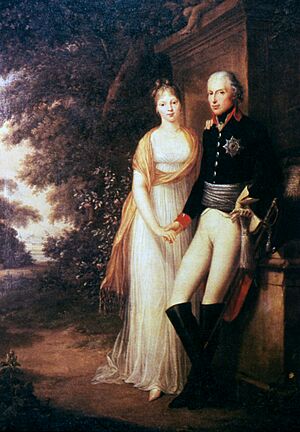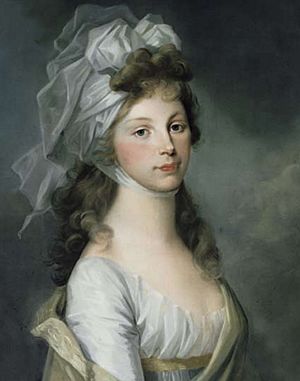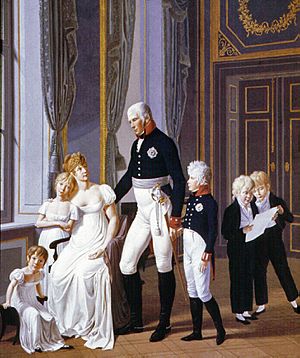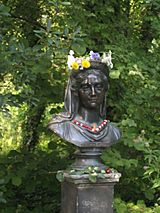Louise of Mecklenburg-Strelitz facts for kids
Quick facts for kids Louise of Mecklenburg-Strelitz |
|||||
|---|---|---|---|---|---|

1802 portrait by Josef Grassi
|
|||||
| Queen consort of Prussia | |||||
| Tenure | 16 November 1797 – 19 July 1810 | ||||
| Electress consort of Brandenburg | |||||
| Tenure | 16 November 1797 – 6 August 1806 | ||||
| Born | Duchess Louise of Mecklenburg-Strelitz 10 March 1776 Hanover, Electorate of Hanover, Holy Roman Empire |
||||
| Died | 19 July 1810 (aged 34) Schloss Hohenzieritz, Kingdom of Prussia |
||||
| Burial | Mausoleum at Charlottenburg Palace | ||||
| Spouse | |||||
| Issue |
|
||||
|
|||||
| House | Mecklenburg-Strelitz | ||||
| Father | Charles II, Grand Duke of Mecklenburg-Strelitz | ||||
| Mother | Princess Friederike of Hesse-Darmstadt | ||||
| Religion | Lutheran | ||||
| Signature | |||||
Louise of Mecklenburg-Strelitz (born March 10, 1776 – died July 19, 1810) was the Queen of Prussia. She was married to King Frederick William III. Their marriage was happy, though it ended early. They had nine children together. Two of their sons, Frederick William IV of Prussia and Wilhelm I, later became kings.
Louise is remembered for her important meeting with French Emperor Napoleon I in 1807. She tried to get better peace terms for Prussia after they lost badly in the Napoleonic Wars. Her people already loved her, but this meeting made her even more admired. She became known as "the soul of national virtue." Louise died young, at age 34. Napoleon reportedly said that the king "has lost his best minister." Four years later, her husband created the Order of Louise to honor her. It was a special award for women, like the Iron Cross for men.
Contents
Early Life as a Duchess (1776–1793)
Louise Auguste Wilhelmine Amalie of Mecklenburg-Strelitz was born on March 10, 1776. She was born in a villa outside Hanover. Her father was Duke Charles of Mecklenburg. Her mother was Princess Friederike of Hesse-Darmstadt. Louise was the sixth child in her family.
At the time of her birth, her father was not yet the ruler of Mecklenburg-Strelitz. He became Duke in 1794. Her father worked for King George III of the United Kingdom. The family moved to Leineschloss, a royal residence. They often spent summers at Herrenhausen.
Louise was very close to her younger sister, Frederica. She was also close to her only brother, George. Their governess, Fräulein von Wolzogen, took care of them. When Louise was six, her mother died during childbirth. This deeply affected Louise. She often gave money to children who had also lost their mothers.
After her mother's death, the family moved to Herrenhausen. Two years later, her father married her mother's younger sister, Charlotte. Louise became close to her stepmother. But Charlotte also died early, just a year after their marriage. Her father, now a widower twice, took the children to Darmstadt. He left them with their grandmother, Landgravine Marie Louise.
Her Education and Interests
Louise's grandmother raised the children simply. They even made their own clothes. A new governess, Madame Gelieux from Switzerland, taught them French. Like many royal children then, Louise became fluent in French. She learned less of her native German. She also received religious lessons from a Lutheran clergyman.
Charity was an important part of her education. Louise often visited poor and needy families with her governess. She was encouraged to give what she could. Sometimes, she got into trouble for giving away too much. From age ten until her marriage at 17, Louise spent most of her time with her grandmother and governess. Both were well-educated women.
When she was nine, Louise heard the poet Friedrich Schiller read from his play "Don Carlos." This sparked her love for German literature. She enjoyed reading Schiller, Goethe, Paul, Herder, and Shakespeare. She also loved ancient Greek tragedies.
In 1793, Louise's grandmother took her and Frederica to Frankfurt. There, they met King Frederick William II. Louise had grown into a beautiful young woman. She had "an exquisite complexion" and "large blue eyes." She was also very graceful.
Louise's uncle wanted to strengthen ties with Prussia. So, he arranged for Louise to meet the king's son, Crown Prince Frederick William. Louise was 17, and the Crown Prince was 23. He was serious and religious. Louise made such a good impression that he immediately wanted to marry her. His younger brother, Prince Louis Charles, was interested in Frederica. The families planned a double engagement. They celebrated a month later, on April 24, 1793. Frederick and Louise married on December 24 that year. Louis and Frederica married two days later.
Crown Princess of Prussia (1793–1797)
Louise's arrival in Berlin, the capital of Prussia, caused a stir. The city's people gave her a grand welcome. She broke royal rules by stopping to pick up and kiss a child. A writer noted that "The arrival of the angelic Princess spreads over these days a noble splendor." Another wrote that "All hearts go out to meet her."
Louise's father-in-law, King Frederick William II, gave the couple Charlottenburg Palace. But the Crown Prince and Louise preferred to live at Paretz Palace. This was outside Potsdam. Louise enjoyed taking care of their home there. Paretz was quiet, away from the busy court. The couple liked the "rural retirement" of country life.
Their marriage was happy. Louise was well-loved by the king. He called her "the princess of princesses." He also gave her a palace in Oranienburg. Louise felt it was her duty to support her husband. They enjoyed singing and reading Shakespeare and Goethe together.
Louise soon became pregnant. She gave birth to a stillborn girl in 1794. After that, she had nine healthy children. Two of them died in childhood. Their children included Crown Prince Frederick William (born 1795) and Prince William (born 1797). The family also used the Crown Prince's Palace in Berlin.
Louise continued her charitable work throughout her life. At a harvest festival, she bought presents for local children. On her first birthday after her marriage, King Frederick William II asked what she wanted. Louise asked for money to share her joy with the city's people. He gave her a large amount for this purpose.
Queen of Prussia (1797–1810)
On November 16, 1797, Louise's husband became King Frederick William III. Louise wrote to her grandmother, "I am now queen." She was most happy that she no longer had to limit her good deeds. The couple had to leave their quiet life at Paretz. They began living under the rules of a royal court.
They toured the country's eastern parts. The king wanted to meet his new subjects. Frederick William also wanted to introduce the queen to their people. This was unusual for a queen at the time. Louise was welcomed everywhere with celebrations. For the first time in Prussian history, the queen became a public figure. She had a much more important role than earlier queens. Louise's presence on this journey was a break from tradition. Her power came from supporting her husband. She used her intelligence to help him. She also became a fashion trendsetter. She wore a neckerchief to avoid getting sick.
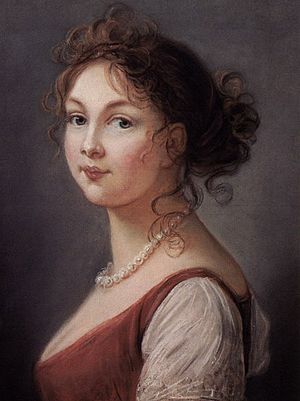
After her husband became king, Louise became a powerful figure in the government. She earned everyone's respect and affection. The queen made sure to stay informed about political events. From the start of his reign, the king asked Louise for advice on state matters. Frederick William was careful and disliked war. He said in 1798 that he wanted to keep peace.
Prussia remained neutral during the early Napoleonic Wars (1803–15). The king refused pressure to pick a side. Louise supported this view. She warned that joining other powers like Austria, Great Britain, and Russia would make Prussia dependent on Russia. She knew Prussia was the weakest of the great powers. French actions eventually made the king consider war. But he couldn't decide which side to join. He listened to many opinions, including Louise's. He was finally forced to ally with Napoleon.
Baron vom Stein, a government official, wanted to reform the government. He wanted to change it from favoritism to a responsible system. He wrote a document for the king about these reforms. This document reached Louise through General Ernst von Rüchel. Louise agreed with its ideas. But she thought it was "too violent" for the king. So, she helped keep it from him.
War with France
Among the king's advisors, Louise and Prince Louis Ferdinand wanted war against France. Others, like Baron vom Stein and Karl August von Hardenberg, wanted reforms but not necessarily war. Hardenberg spoke directly to the queen for reforms. This was smart, as the king saw demands to remove his advisors as a "mutiny."
Prussia had not fought a war since 1795. Its military leaders were confident they could beat Napoleon's troops. After a small incident involving an anti-French pamphlet, Louise and her family pressured the king. He finally agreed to go to war. Prussian troops began to mobilize. In October 1806, the Battle of Jena-Auerstedt was a disaster for Prussia. Their army was almost completely destroyed. The king and queen had joined their troops at Jena. Louise was dressed "like an Amazon." But they had to flee from the French.
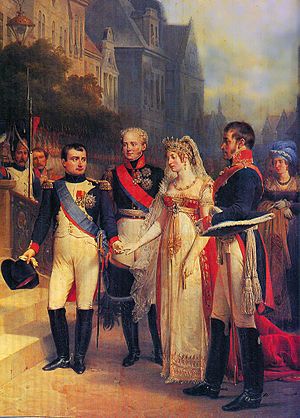
Napoleon himself took over Berlin. The royal family had to escape to Memel. This was in the eastern part of the kingdom. Louise was ill during this journey. There was no food or clean water. The king and queen had to share sleeping spaces in "wretched barns."
Napoleon demanded peace terms after these events. This was called the Peace of Tilsit (1807). He agreed to keep half of Prussia intact. Queen Louise joined the men. Frederick William had sent for her. She was pregnant with her daughter Princess Louise. He wanted her to beg for a better deal for Prussia. Louise told her husband, "For God's sake no shameful peace." The king felt her presence might make Napoleon "more relaxed." Louise reluctantly agreed to meet Napoleon at Tilsit. She did it only to save Prussia.
Napoleon had tried to ruin her reputation. He questioned her loyalty to her husband. But Louise met him anyway. She tried to use her beauty and charm to get better terms. She used to call him "the Monster." But she asked for a private meeting. She even knelt before him. Napoleon was impressed by her grace. But he refused to make any changes. He wrote to his wife Empress Joséphine that Louise "is really charming." Napoleon's attempts to harm Louise's reputation failed. They only made her more loved in Prussia. Her efforts to protect Prussia from France made her admired for generations.
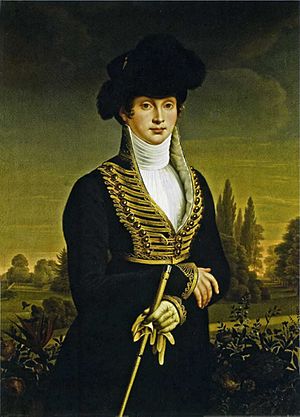
Final Years
Prussia faced harsh rules after the war. They had to pay a huge amount of money, 120 million francs. This was equal to Prussia's entire yearly budget. French soldiers were also stationed in Prussia. Louise was seen as a symbol of Prussia's pride. The French occupation deeply affected her. Napoleon even called her "the only real man in Prussia."
Louise knew Prussia depended on her for strength. So, she regained her optimism. She often prepared her oldest son for his future as king. In the next few years, Louise supported government reforms. These were led by Stein and Hardenberg. She also supported military reforms by Gerhard von Scharnhorst and August Neidhardt von Gneisenau. After the disaster at Tilsit, Louise helped Stein get his job back. She told Frederick William, "[Stein] is my last hope."
By 1808, it was still not safe to return to Berlin. The royal family spent the summer near Königsberg. Louise believed that the hard times would be good for her children. In the winter of 1808, Tsar Alexander I invited the king and queen to St. Petersburg. She was treated to beautiful rooms there. "Nothing dazzles me anymore," she said upon returning to Germany.
Near the birth of her youngest child, Princess Louise, in 1809, Louise wrote to her father. She said that their troubles had not harmed their family life. Instead, they had made it stronger. Louise was sick for much of that year. But she returned to Berlin with the king after three years away. She arrived with her daughters Charlotte and Alexandrine and younger son Charles. Her father greeted her at Charlottenburg Palace. However, the palace had been looted by Napoleon's forces. A preacher observed that Louise was "far from joyful." Her eyes had "lost their former sparkle."
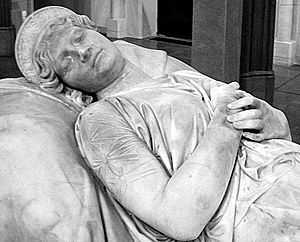
On July 19, 1810, Queen Louise died while visiting her father in Strelitz. She died in her husband's arms from an unknown illness. Some accounts suggest she had a botched operation for a neck swelling, which led to an open sore. Her subjects believed the French occupation caused her early death. "Our saint is in heaven," said Prussian general Gebhard Leberecht von Blücher. Louise's death left her husband alone during a difficult time. The Napoleonic Wars and need for reform continued.
Louise was buried in the garden of Charlottenburg Palace. A mausoleum was built over her grave. It contains a beautiful statue by Christian Daniel Rauch. Frederick William did not remarry until 1824. He married his mistress Auguste von Harrach. He said he needed "Womanly companionship." After his death in 1840, Frederick William was buried next to her.
Her Lasting Legacy
Queen Louise was seen as the "soul of national virtue" by her people. Some historians say she represented "Prussian nationalism." She was a famous woman who combined goodness, modesty, and royal grace with kindness. Her early death at 34 made her stay young in people's memories. Her reputation as a loving and loyal wife was key to her lasting fame. The admiration for Louise became linked with ideal female qualities: beauty, kindness, motherly care, and being a good wife.
In 1814, on her birthday, her widowed husband King Frederick William created the Order of Louise (Luisenorden). This was a special award for women who helped in the war against Napoleon. It was later given to other members of the House of Hohenzollern. In 1880, a statue of Queen Louise was put up in the Tiergarten in Berlin.
Louise inspired a conservative women's group called Königin-Luise-Bund. It was often called Luisenbund ("Queen Louise League"). This group almost worshipped her. Its main goal was to promote patriotic feelings among German women. It focused on family and German values. The Queen Louise League was active during the Weimar Republic and early Nazi Germany. Even though they supported the National Socialist movement, the Nazis disbanded the group in 1934. They saw it as a rival organization.
Queen Louise in Popular Culture
Queen Louise was a popular subject in German films. These included Der Film von der Königin Luise (1913) and Vivat – Königin Luise im Fichtelgebirge (2005). She was played by Mady Christians in Queen Louise (1927). Henny Porten played her in Louise, Queen of Prussia (1931). Ruth Leuwerik played her in the 1957 film Queen Louise.
She also appeared briefly in the 1945 propaganda film Kolberg. The 1951 film The African Queen features a mission to sink a German warship named Königin Luise. This ship was patrolling Lake Victoria at the start of World War I.
Louise was also the subject of novels by 19th-century German writer Luise Mühlbach. These included Louisa of Prussia and her Times and Napoleon and the Queen of Prussia.
Her Children
Louise had children with Frederick William III of Prussia. They married on December 24, 1793.
| Name | Birth | Death | Notes |
|---|---|---|---|
| Unnamed daughter | 1 October 1794 | 1 October 1794 | Stillborn. |
| Prince Friedrich Wilhelm, later Friedrich Wilhelm IV | 15 October 1795 | 2 January 1861 | married Princess Elisabeth Ludovika of Bavaria (1801–1873), no issue |
| Prince Wilhelm Friedrich Ludwig, later Wilhelm I | 22 March 1797 | 9 March 1888 | married Princess Augusta of Saxe-Weimar-Eisenach (1811–1890), had issue |
| Princess Friederike Luise Charlotte Wilhelmine | 13 July 1798 | 1 November 1860 | married Tsar Nicholas I of Russia, had issue including the future Alexander II of Russia |
| Princess Friederike | 14 October 1799 | 30 March 1800 | died in childhood |
| Prince Friedrich Karl Alexander | 29 June 1801 | 21 January 1883 | married Princess Marie of Saxe-Weimar-Eisenach and had issue. |
| Princess Friederike Wilhelmine Alexandrine Marie Helene | 23 February 1803 | 21 April 1892 | married Paul Friedrich, Grand Duke of Mecklenburg-Schwerin and had issue. |
| Prince Friedrich Jules Ferdinand Leopold | 13 December 1804 | 1 April 1806 | died of diphtheria in childhood. |
| Princess Luise Auguste Wilhelmine Amalie | 1 February 1808 | 6 December 1870 | married Prince Frederick of the Netherlands, had issue. |
| Prince Friedrich Heinrich Albrecht | 4 October 1809 | 14 October 1872 | married Princess Marianne of the Netherlands and had issue. Married secondly to Rosalie von Rauch, Countess of Hohenau, daughter of Gustav von Rauch, had issue. |
|
See also
 In Spanish: Luisa de Mecklemburgo-Strelitz para niños
In Spanish: Luisa de Mecklemburgo-Strelitz para niños


